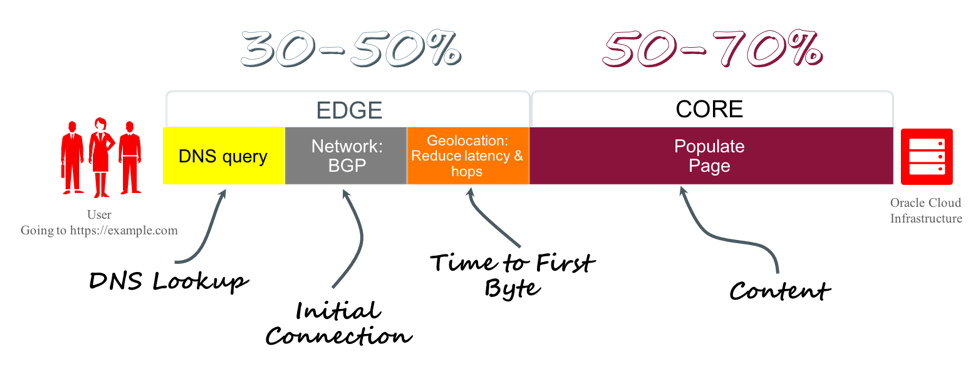A great application or digital experience starts with the user. However, the inception of the cloud has generally treated the user experience as an afterthought, focusing on building environments suited to process applications data, store that data and effectively move data in between. If moving applications and resources to the cloud means not being able to deliver the same consistent performance users had before, user experience will be impacted in a negative way. This leads to heavily invested applications going unused by employees, customers abandoning digital assets and/or partners going to other suppliers due to a better workflow and ordering process.
This application-first view resulted in the first generation of clouds being designed to deliver a large number of basic compute nodes you could deploy on demand, along with copious storage. This was great for start-ups to build applications or for larger organizations to “get their feet wet” with less critical applications by providing greater flexibility, quicker deployments, lower capital expense, and improved operational efficiency. But it didn’t put the user first.
This is part one of a two-part series that will look at the importance of getting users to cloud-hosted applications and data or what we term the cloud edge.
Moving to the Cloud Can Leave You in the Dark
Today, as large enterprises look to move more business-driving applications to the cloud and as those applications are more resource intensive, workloads grow. For that reason, the need for increased power is still at the top of the list. However, other factors around delivering a consistent and high-quality experience are now driving new requirements.
Here is why! The challenge stems from applications and data being widely distributed in this new model, housed in multiple clouds, content delivery networks (CDNs) or even traditional data centers. Add to this the fact that the users and devices accessing them are virtually everywhere. This means that you no longer connect everything through dedicated and owned channels – you can now interconnect these assets through the internet. The internet is not as consistent when it comes to performance as we’d like, leading to slower performance and interruptions in service for end users.
Bob Gill of Gartner states, “User expectations are high and continue to rise. One side effect of digital business is that businesses interact with their customers digitally and directly; if an experience is poor, it reflects poorly on the business and its brand.” (Source)
Issues that customers, partners or employees will blame on your services, technology, and brand.
The foundational problem with relying on the internet to connect all this together is that you relinquish visibility and control which hides how your services are being delivered. So when users have a poor experience you have no way identifying it or quickly remediating it if the root cause of the problem occurs before entering the cloud.
Managed DNS: The First User Interaction
Most people in IT understands that we use the Domain Name System or DNS to translate the URLs we type in our web browsers to IP addresses. Today Managed DNS services can do so much more when it comes to user experience.
Previously Kyle York, GM&VP, Business Product and Strategy for the Oracle Dyn Global Business Unit (GBU) wrote about DNS as a cloud infrastructure strategy, read the blog here.
Almost every first-generation cloud provider offers DNS services, whether directly or through partnerships. Alternatively, many organizations still use in-house DNS servers. More often than not, these DNS services are pretty basic and fall short in providing the visibility and control that is needed. The reason is that they are low-cost or “thrown-in” services, and therefore don’t warrant heavy development investment. If in-house, they are usually set and left to run. Resulting in a best-effort service that may or may not deliver a quality user experience.
The enterprise-ready cloud has to rethink DNS to deliver the best user experience. As applications and data become more distributed, the ability to intelligently choose the optimal path to that data becomes business-critical. Up to half of the wait end users experience is due to the edge network and improvements here pay big dividends in terms of end user experience. Fast communication within your cloud, among your compute nodes and storage, isn’t enough.

As data moves to the cloud and is replicated across regions and availability domains within those regions, each DNS lookup will create choice for determining the optimal use of assets. A Managed DNS provider builds intelligence into the decision-making process—taking into account user location, services awareness, internet conditions and asset status. All of these things will factor into creating a response that is uniquely suited for the moment.
The User-First Perspective
With emphasis on horsepower in the cloud and with organizations investing in the cloud to house and support their key applications, it is easy to lose sight of the importance of the edge. This is where your employees and customers connect to your business and it start with DNS. A poor experience can have significant impact to your brand reputation and bottom line.
When looking at adopting a cloud strategy that is truly enterprise-ready, you need to look at the total path between user and content.
If you want to find more about Dyn technologies visit the Oracle + Dyn website.
In my next blog I will examine some strategies at the edge to maximize performance and availability for a better user experience.
